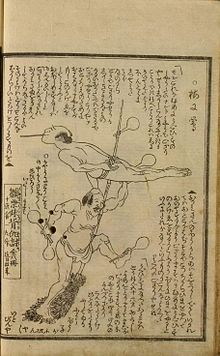
The kokkeibon (滑稽本, literally "comical book") was a genre and type of early modern Japanese novel. It came into being late in the Edo period during the 19th century. As a genre, it depicted the comical behavior occurring in commoners' daily lives.
The kokkeibon genre is the successor of the dangibon genre. Jippensha Ikku's Tōkaidōchū Hizakurige (1802–1822) is identified as the first representative novel. A less strict definition includes the dangibon as an "early kokkeibon".
Kokkeibon generally consists of dialogue among the main characters and includes illustrations. The genre was most popular between 1804 and 1830, and is best represented by the works of Jippensha Ikku and Shikitei Sanba.
See also
References
- Kubota, Jun (2007). Iwanami Nihon Koten Bungaku Jiten [Iwanami Dictionary of Japanese Classical Literature] (in Japanese). Tokyo: Iwanami Shoten. ISBN 978-4-00-080310-6. OCLC 122941872.
- Nihon Koten Bungaku Daijiten: Kan'yakuban [A Comprehensive Dictionary of Classical Japanese Literature: Concise Edition]. Tōkyō: Iwanami Shoten. 1986. ISBN 4-00-080067-1. OCLC 22820487.
| Gesaku genres | |
|---|---|
This Japanese literature–related article is a stub. You can help Misplaced Pages by expanding it. |